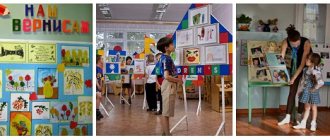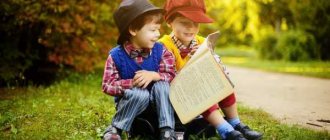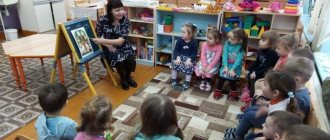Work with parentsconsultation (junior, middle, senior, preparatory group) on the topic
Consultation for parents
"Child safety on the street"
Child safety on the street
Perhaps some parents of children will think that this article is not for them. It will take many more years until the baby is old enough to walk on his own. All this is true. But it is necessary to instill responsibility in a child from an early age. The sooner you explain to your child the rules of safe behavior on the street, the more likely it is that he will not forget science and will be able to use these lessons correctly if necessary. Your task is to teach your child to behave correctly in extreme situations.
A yard without danger
Modern children begin to walk unaccompanied by their parents much later than we ourselves did during our childhood. But it’s worth preparing the baby for independent “going out” in advance. So, while walking with your baby, go around the entire yard and pay attention to the most dangerous places: hatches, basements, attics, construction sites. It’s important not to just say: “You can’t go here! Is it dangerous!" It is necessary to explain clearly why exactly it is impossible: you can fall into the hatch, someone can close the basement door, and then the child will remain there in captivity (if the baby is locked in the basement, there is no need to scream and cry, it is better to knock on the door with all your might - this will happen sooner) someone will hear and come to the rescue).
Even cars parked near the house can pose a great danger. Usually, kids clearly understand that they need to be extremely careful with moving cars. But a stationary car does not cause them concern. Tell your child that the car can suddenly move, and the driver will not notice the baby, who, playing hide and seek, hid behind the trunk. Therefore, you cannot run, much less hide around cars, and if a ball rolls under a car, you need to turn to adults for help.
Kids love to play hospital, store, or “cook” dinner for dolls on a toy stove. To do this, they tear plants growing nearby (grass, flowers, leaves) and collect seeds. And this is not always used “for fun”. The child can taste the prepared “medicine” or the doll’s “soup”. But not all plants are as harmless as they might seem. For example, castor beans, which in recent years have often been grown at the entrances of houses (popularly called “palm trees”), have deadly poisonous seeds. It is enough for a child to swallow 2-3 seeds to get serious poisoning. Be sure to explain to your child that no plants, berries or seeds picked on the street should be put into the mouth. And for the game it is better to use harmless and well-known plants, for example, dandelion, plantain, rowan.
When walking with your baby in the yard, you must be firmly sure that there are no open sewer manholes around. The statistics are merciless: hundreds of children die and are injured precisely for this reason. And here no warnings “watch your step” and “don’t step” will help. In the excitement of active play, a child may simply not notice the danger. Therefore, do not rely on public utilities, but take the initiative into your own hands: conduct periodic inspections with other parents and close the hatches with boards.
Equipment rules
When dressing your baby for a walk, check his clothes. It would be better if it had no laces that could get caught. It is desirable that the shoes fit tightly on the foot and do not “slip”. This will make your child's games safer.
Life on the playground
It’s so good that there are playgrounds with swings in the courtyards! And how bad it is at the same time that they exist! Modern heavy iron structures have truly destructive power. And if such a swing hits a child at high speed, it could end in disaster. Danger awaits not only the tiny foolish ones who get close to the swings while their mothers are enthusiastically chatting on the bench. And older children sometimes cannot correctly assess the safe distance. Therefore, you must clearly explain to the child that you can only approach the swing from the side, and walk around it at a great distance. You need to sit down and get off only when the swing is stopped, and under no circumstances should you jump from it. Tell us what the consequences of violating these rules may be.
Merry-go-rounds can also seriously hit your baby if you don’t follow basic safety rules. Just as in the case of the swing, remind your baby often that approaching the spinning carousel is dangerous. First you need to wait for them to stop, and only then sit down on the seat. And, of course, hold on tight.
Any kid knows that ladders, horizontal bars, monkey bars, in a word, sports equipment, are very interesting and fun things. They develop agility, endurance, and coordination of movements. And mom won’t forbid you to climb and hang on them to your heart’s content. Of course, provided that the baby does all this with due care. First of all, pay attention to the surface of the playground. If it is sand, grass, sawdust, or, as a last resort, small gravel, feel free to send your baby there. If the site is concreted or paved, it is better to look for another place to play. Teach your child how to jump off a ladder or horizontal bar correctly. When a child swings on the bar, he needs to jump at the moment when the body begins to move backward. Otherwise, you can easily fall.
All kinds of slides are a favorite pastime for children. But moms and dads should pay attention to their condition before letting the baby roll away with the breeze. If the handrails or sides of the slide are wooden, then parents need to check how well the surface is treated to avoid splinters on children’s hands. For preschool children, the height of the slide should not exceed 1.2 m. Check whether the slide covering is intact and whether there are any nicks on it. From the “correct” slide, the baby rolls down without stopping to the very bottom and does not fly to the ground, but lingers on a special, raised ledge. The kid should know that slides are not a place for pampering. You need to get up and down carefully and carefully, respect the queue and under no circumstances push other children. This could result in serious injury. Of course, you don’t have to stand next to the slide and look after your baby all the time. But it is better not to let the child out of sight in order to respond in time to the dangerous behavior of children.
Forbidding children to climb trees is useless. All the same, sooner or later, they will test the strength of the surrounding trees. And to avoid falls and injuries, it is better to teach your child to do it correctly. First of all, only old trees with thick trunks and branches are suitable for climbing. A young tree can be easily damaged, and it will die, and the baby itself, standing on a thin branch, will fly down. You need to lean only on thick living branches and, under no circumstances, on dry ones. You should first check the strength of the branch, and only then stand on it. And one more thing: make sure that your child alternates between arms and legs when climbing: for example, first he grabs his arm, then moves his leg. Supporting three limbs at the same time reduces the risk of falling.
Roller skating or cycling are useful activities in all respects, but at the same time quite dangerous. First of all, take care of the protective equipment for little athletes. All kinds of helmets, knee pads and elbow pads are not just fashionable gadgets, but something that will protect the baby not only from broken knees and skinned hands, but also from much more serious injuries. Be sure to select a helmet for roller skating with fitting. It should sit comfortably on the head, cover the forehead, but not slide down into the eyes. Special fingerless gloves will also be useful. It is better to roller skate in specially designated areas. It’s easier with a bicycle, just be sure to teach your child to be attentive to “pedestrians” and not to develop high speed where there is a chance of hitting one of the kids. If you and a small cyclist need to cross the roadway, be sure to remove him from the bicycle and lead him across the road by the hand, driving the bicycle separately. And, of course, never let the little “racer” out of your sight.
Fighting is a common cause of serious injury in children. More often this is the lot of boys, but there are also cocky girls who are ready to “deal” with the offender with their fists. And fists are half the trouble. Often improvised objects are used: sticks, pieces of iron, stones, etc. One of the main reasons is very simple: the guys do not yet understand how seriously they can injure the enemy with these objects. The usual movie stereotype comes into play: the hero was hit on the head with a huge cobblestone, but he is not only alive, but also completely healthy. Such scenes distort our children’s understanding of the real force of impact, of pain, of how fragile and vulnerable a thing human life really is. And who else, if not mothers and fathers, should convey these simple truths to kids? If we talked to all children about the possible consequences of such fights, there would be much less childhood traumatism...
Another danger is large and small four-legged animals, not only stray ones, but also real domestic ones. We are talking not so much about dangerous diseases that animals can carry, but about dog aggression, of which children sometimes become victims. Undoubtedly, you must instill in your child love and trust for his smaller brothers, but the child must clearly know that dogs are different and not always kind. In addition, it is better not to approach unfamiliar animals at all. Tell your child not to wave your arms or a stick near the dog. She will think that they want to hit her and may bite her. You should not pet or cuddle an unfamiliar dog. She might not like it. The child must know how to behave when attacked by a dog. If there is no shelter nearby - a driveway or a tree - you should not run away, the dog will still catch up. Show your baby how to protect his face and neck by pressing his chin to his chest and covering himself with his arms bent at the elbows. And adults will definitely come to the rescue.
Beware: stranger!
Even if your child is still too young to walk without adults and you are not going to let him go out alone yet, he must clearly understand the basic rules of communicating with strangers. Most of us instill in our children that they need to be well-mannered and polite towards people, not to be rude or lie. All this is, of course, true. But it is quiet, well-mannered children who more often become victims of criminals. After all, it’s so easy to deceive them, and they themselves are accustomed to always tell adults only the truth. What to do, is it really necessary to raise a child to be a liar and a rude person? There is no need to raise a rude person, but it is simply necessary to explain to the child that among good and kind people there are sometimes bad ones. From early childhood, a child must clearly know important rules:
Never talk to strangers or take anything from them.
Never get into a stranger's car or go anywhere with him.
You cannot take ANYTHING from a stranger: neither candy, nor toys, nor gifts, nor anything that “needs to be given to mom.” In a situation where a child is asked to go or go somewhere with a stranger (“see the Barbie collection”, “play a movie”, “feed the kittens”, etc.), the child should answer only one thing: “Now I’ll ask my mother’s permission " The child must also be prepared for provocation from a stranger: “I thought you were already big, but you keep asking your mother for permission!” The answer in this case must be firm and unambiguous. Explain to your child that if someone grabs him by the arm and drags him somewhere or tries to push him into a car, ABSOLUTELY all methods of self-defense are permitted. You can be rude, lie, kick, bite, scream. By the way, in such a situation you should not shout “Help!”, but “This is not my dad (mom)! My name is so-and-so, call my parents at number so-and-so!”
From a very early age, instill in your child that his body belongs only to him and no one has the right to touch the baby without his consent. Try not to cuddle or kiss your child if he doesn't want to at the moment. And never let other people do this. The baby must clearly know that no one has the right to pick him up without his mother’s permission, and if this happens, then it is quite possible to behave in a not very mannered manner: scream loudly and even kick.
Instill in your child that you will never send a stranger to pick him up from kindergarten. And if something like this happens, the baby should not go anywhere with this person, even if the stranger assures that his mother (father, grandmother, etc.) sent him. And remind me of all this more often, more often, more often! Children so easily forget everything we teach them...
I'm lost!
Any parent who has ever lost their child (even if only for a couple of minutes) is almost certainly familiar with the all-encompassing feeling of panic that chills the body and prevents them from thinking soberly. A baby who suddenly discovers that mom or dad isn't around is no better. He is scared alone in a crowd of strangers. And even if you try not to let go of your baby’s hand in crowded places, situations when a child gets lost are not that rare. But, if both the parents and, most importantly, the baby clearly know how to behave in extreme situations, trouble will not happen. Let's teach our little one the correct behavior in public places so that we never have to go through these terrible moments.
At the supermarket. First of all, the baby must clearly understand that when making family purchases with mom and dad in a large store, he should not lose sight of his parents. Holding a child's hand all the time is almost impossible, because every now and then we stop at shop windows, pick up some product, and are distracted from the baby for a short time. This time is quite enough for a nimble, curious toddler to sneak away from his parents, get lost in the crowd, or linger in the toy department. Therefore, accustom your child to the idea that it is not you who are watching him, but HE is watching you. If the baby no longer fits into the shopping cart, let him hold on to it with his hand and certainly tell you that he wants to linger near this or that product. Then you just stop and wait for him. Tell your child what he should do if he suddenly doesn’t find his parents nearby. Instill in your child an important thought: you love him very much, worry about him and will never scold him, even if the baby got lost due to his own negligence, not following your rules. This will help him remember everything you taught him and do the right thing. The best thing a child can do when lost in a crowd is to stay still and wait. You can even sit on the floor. Sooner or later, mom and dad will certainly find him. The child should know that under no circumstances should he leave the store to “wait for his parents near the car.” Unfortunately, not all supermarkets have security guards who will not let a child go out alone. Tell us, or better yet, show your child the people you can turn to for help: police officers, security guards, supermarket employees, cashiers. In a word, all people are in uniform. You can trust them, they will help. The child should not go with anyone else, even if this person seems kind and good and promises to take him to his mother. If someone tries to take him away by force, let him shout loudly: “Dad! Mother!" A child who can speak well should know by heart his first and last name, home address and, it would be nice, telephone number. This information must be learned with the child and must be repeated from time to time. While kids remember their first and last names well, they often forget their address. It would not be bad, when going to crowded places with your child, to put a note in the pocket of his clothes with the name, surname, address and mobile phone numbers of the parents. Even better, engrave this data on a metal plate, attach it to a chain and fasten it inside the pocket of children's trousers so that the baby does not inadvertently lose it. Nowadays you can find special keychains on sale where all the information about the child is recorded.
At the station, at the airport. All the rules mentioned above are true here. You just need to watch your baby even more carefully, because there are much more dangers at the station than in the store. Every time you find yourself at a train station or airport when going on a trip, remind your child of the rules of behavior. Draw his attention to the fact that under no circumstances should he leave you anywhere without asking permission. If it gets lost, you can turn to police officers, security guards, and cashiers for help.
In the subway. When entering the train car, hold your child tightly by the hand and let him pass in front of you. Just in case, explain to your child how to behave if he finds himself in a carriage, the doors slam shut, and you remain on the platform. Even if it seems to you that this will never happen to you, it is better to be prepared for any surprises. The kid should know that, having passed one station, he should get out of the car, move away from the edge of the platform and wait for you. And you will certainly arrive on the next train. If everything happened exactly the opposite (the mother left, and the baby remained on the platform), then there is no reason to panic here either. Again, you need to move away from the edge of the platform (it’s better to sit on a bench if there is one nearby) and wait for mom.
In the park, in the forest. Walking in the park is a wonderful opportunity to spend quality time with the whole family. And in order for such a vacation not to turn into a complete hassle for you, from a very early age it should be an absolute taboo for your child to go too far from you. Of course, walking in the park solely hand in hand with your mother is stupid. But running away and, especially, “hiding” from her is absolutely unacceptable. The baby must know that he can only run and play where his parents can see, and they, in turn, must see him.
It is not uncommon for children to look for entertainment on their own during a family picnic in the forest, while the adults are busy making a fire or preparing barbecue. And it happens, as in that fairy tale about Masha and the Bear: tree after tree, bush after bush, so they moved quite far from the camp. It's very easy to get lost in the forest. And very scary. But if your baby clearly understands that YOU NEED TO STAY IN PLACE, you will find him very quickly. In this case, adults should split up, going on searches simultaneously in different directions, periodically calling out to the child. The baby, in turn, should also loudly call for help. It is very useful to buy your child a good whistle for walks in nature. And if he is lost in a forest or park, his whistle will be clearly audible for hundreds of meters.
If there is a pond in a park or forest, you will need additional attention. Moreover, even a very shallow depth can pose a danger to the baby. Do not allow the baby to approach the water alone, but do it together. If the shore is flat, the baby can play by the water under your constant supervision. If the bank is steep, under no circumstances let go of the child’s hand and do not come close to the edge.
Attention, road!
First of all, it is very important to always follow the traffic rules yourself. If, when walking with your child, you cross the road only when the light is green, use above-ground and underground pedestrian crossings, your child will learn from early childhood that this is what you need to do and not otherwise. If we ourselves often neglect these simple rules, all our moral teachings will be an empty phrase for the child. Children copy adults in everything, remember this. Why can’t a child cross the road in the wrong place if his mother does the same, even occasionally? It is better to be patient and wait an extra minute for the green light than to teach your child that it is acceptable to not follow the rules.
Every time you cross the road with your baby, say the algorithm. Teach your child to look carefully at the road, even if you are walking at a green traffic light. Unfortunately, there are drivers for whom the rules are not written... Explain to your child the purpose of a zebra crossing on the road, figure out what certain road signs mean. It would be great to play at home with toy cars and plush “pedestrians”, drawing traffic signs on sheets of paper and hanging traffic signs around the apartment. Any science is better remembered in the game...
Be careful when traveling on public transport and teach your child to be careful. Do not neglect the rules, no matter how simple they may seem to you. You should approach the doors of a bus, trolleybus or minibus only after the transport has come to a complete stop, otherwise you may slip and end up under the wheels. In addition, you may be pushed by one of the passengers pressing behind you. When entering a tram or bus, let your child pass first. It is better to take the smallest ones in your arms. Get out of the vehicle first, then help your baby get out, holding his hand.
An elevator is not exactly a vehicle, but like any mechanism it can pose an extreme danger. An adult always enters the elevator when it opens, followed by a child. It is better to hold the baby's hand. When leaving, it’s the other way around: the child goes first, the mother follows. Don't let your child jump in the elevator - this could cause him to get stuck.
Dear parents, remember that children's safety depends on us. The task of adults is not only to constantly look after and protect children. We simply have to teach them to take care of themselves. But this must be done competently and carefully so that the baby does not perceive the world around him as hostile, full of dangers, troubles and evil people. No, the world is beautiful and amazing, discovering it is interesting and fun. You just need to always be attentive to yourself and your loved ones. And then troubles will bypass you and your wonderful kids!
Consultation for parents “Child safety on the street” - about how to protect a child from injury, warn, teach how to behave correctly on the playground, in the entrance, in transport.
Working with parents. Requirements for the design of a corner for parents
Larisa Sedova
Working with parents. Requirements for the design of a corner for parents
Requirements for the design of a corner for parents
• Information posted on the stand for parents should be dynamic. The material should be updated at least once every two weeks.
• When placing any printed material at the stand (medical advice, psychologist, etc.), a link to the publication. Including authorship and year of publication is required.
• The stand must be colorfully decorated. When decorating a stand, you should use not only hand-written drawings and inscriptions, but also posters and photographs (preferably children of the group and parents). When designing stands, there is no need to overuse decorative elements, naive images of nesting dolls and toys.
The ratio of text and illustrations in folders should be approximately 2:6 (2 parts - text, 6 - illustrations); they must first of all attract the attention of parents, then convey the necessary information to them
• Reserve should be created for information sharing between groups.
Sections
1. The parent corner contains a tablet about the age characteristics of the children in your group. Throughout the year, the material is updated, including in turn the requirements for physical, mental, and moral. To Trudov. Aesthetic education of children. Features of children’s speech development, self-service skills, etc. (you can indicate what children should know by the middle of the year of study, by the end of the year, etc.)
2. “Our life goes on day by day.” The section presents materials about the past day in the form of drawings, crafts, topics that were analyzed in class (for example, “Today Seryozha asked why sugar is sweet, the lyrics of a song learned in class, the name of a piece of music listened to, a book read to children, etc. The material is constantly updated. It may contain the following appeals: “Mom, learn a tongue twister with me” (text), etc.
3. “Our parents advise” (arbitrary name). In this section, parents can make some proposal to other parents (for example, let’s take the children on an excursion, etc., share experiences (for example, preventing colds, etc.: teachers can also write down tips, referring to parents, from which they heard, information (a children’s book week is taking place in the exhibition hall), advice (possibly a culinary recipe), etc. The page can also be filled out at the request of the parents (for this a questionnaire is developed or an oral survey is conducted). The decision is made by the parent meeting .
4. “Children’s Rights” A section for parents, which contains a variety of information on the observance of children’s rights in a preschool institution, in the family, addresses and telephone numbers where you can turn for help, and official documents.
5. Age group mode. It is permanent, but one of the activities is scheduled during the year, for example
Walk: if a target, then on what date it is planned, preliminary work, task for parents. After a walk-impression for children, a photo montage, a “report from the walk,” children’s drawings and comments on them, etc. is possible.
Long-term role-playing game: when it started, roles, attributes, craft tasks. For example, we play hospital - we need gowns, bandages, gauze bandages, “medicine bottles”, boxes of pills, etc.; We play store - attributes for the store. If the plot is a fairy tale, the tasks change according to the plot of the game, recommendations are given: what to read to the children, what attributes are needed for the game.
This way, you don't just tell or ask parents to replenish your game supply, but show where and how it will be used by children.
Once a month you need to plan individual work with parents to prepare for the lesson.
6. Notice board. Only official information is placed on it (meeting, birth payment, etc.)
7. Menu. The menu can also be used for individual work with parents by making a second pocket in which parents and teachers can place original recipes for their “specialty dishes.”
For example, the kindergarten menu includes breakfast: Masha’s “Favorite Porridge.” S, Artyoma Sh, Styopa F)-manna.
Or lunch: pilaf (original pilaf recipes are included in parental advice).
8. Section for information about the classes of specialists (speech therapist).
Exercise: write down individual complexes (can be preventive, hardening, etc.) Prepared by a physical education instructor.
Music classes (prepared by the music director) - class repertoire, what works were listened to. You can offer a cassette for listening at home with an annotation of musical works.
9. A psychologist and a medical worker prepare materials for movement folders. Once a quarter it is possible to issue a special magazine for parents on a current topic. These magazines are loaned to individual families for one to two weeks. After parents have studied the material, a conversation is held with them on this issue.
In addition to the stand, it is good to have a cabinet or shelves for displaying crafts, drawings, as well as a table for newspapers and magazines
The purpose of the next form of visual propaganda - thematic exhibitions - is to supplement verbal information for parents with drawings, photographs, natural objects (samples of toys, gaming materials, artistic works, etc., made by the hands of children, parents, educators.
Thematic exhibitions are created both for the parent team of the entire kindergarten, and for parents of one group.
You can involve the parents themselves in their design: entrust the selection of material on a certain topic, find clippings from newspapers and magazines, make patterns for homemade toys. Parenting magazines allow parents to become more familiar with this or that parenting issue.
___ Supplement to the magazine “Preschool Education Management”)
“Working with parents in preschool educational institutions” pp. 52-59








